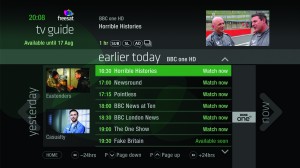
After more than 40 years of operation, DTVE is closing its doors and our website will no longer be updated daily. Thank you for all of your support.
Freesat plans new products, highlights benefits of HTML5
 UK free-to-view satellite platform Freesat plans to develop a ‘headless’ multimedia gateway version of its <free time> advanced set-top, as well as a cheaper ‘zapper’ version without a hard disk that will be launched over the next few months. With regard to services, <free time> will focus primarily on “broadcast-related” services rather than a wider app store following the recent launch of its HTML5 YouTube app.
UK free-to-view satellite platform Freesat plans to develop a ‘headless’ multimedia gateway version of its <free time> advanced set-top, as well as a cheaper ‘zapper’ version without a hard disk that will be launched over the next few months. With regard to services, <free time> will focus primarily on “broadcast-related” services rather than a wider app store following the recent launch of its HTML5 YouTube app.
Speaking at a briefing on Freesat’s launch of the YouTube app on the <free time> platform, James Strickland, director, product and technology development, said: “We are thinking about other categories of <free time> products [in the form of] different versions of the DVR. We will launch cheaper zapper version in a few months and we will also have a headless version that allows you to connect inexpensive devices to TVs in second rooms.”
Freesat recently launched what it described as the first European iteration of version 4 of YouTube’s app for connected TVs which includes adaptive bit-rate streaming as well as features such as the ability to pair the TV with a smartphone to control the service.
Strickland said that Freesat was now designing the next version of the <free time> interface. “We will be building more services but they will be video-centric, widely used services,” he said. “It’s different from the Smart TV approach. We will not have home banking on <free time> anytime soon, but will focus on anything that augments the broadcast experience. We have said we will bring pay services and broadcasters…[however] we know 80% of viewing on-demand content is from the public service broadcasters’ players.”
In addition to YouTube, a version of 4oD and Demand 5, from UK broadcasters Channel 4 and Channel 5, are in development. Freesat is also developing its own smartphone app, which will enable users to control the platform and set recordings via their phones.
Strickland said that Freesat’s decision to adopt HTML5 as the technology of choice for new interactive services would give the platform longevity and serve as an enabler for innovation for years to come. Having launched <free time> wth the Adobe Flash version of BBC iPlayer and the MHEG-based ITV Player, Strickland said that the YouTube app “demonstrates that not only can you get to market quickly but that HTML5 is a global technology. It’s something that allows service providers to deploy quickly and efficiently.”


